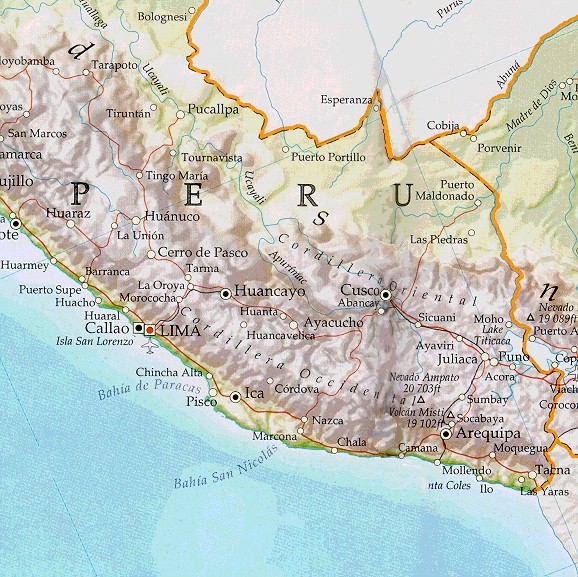|
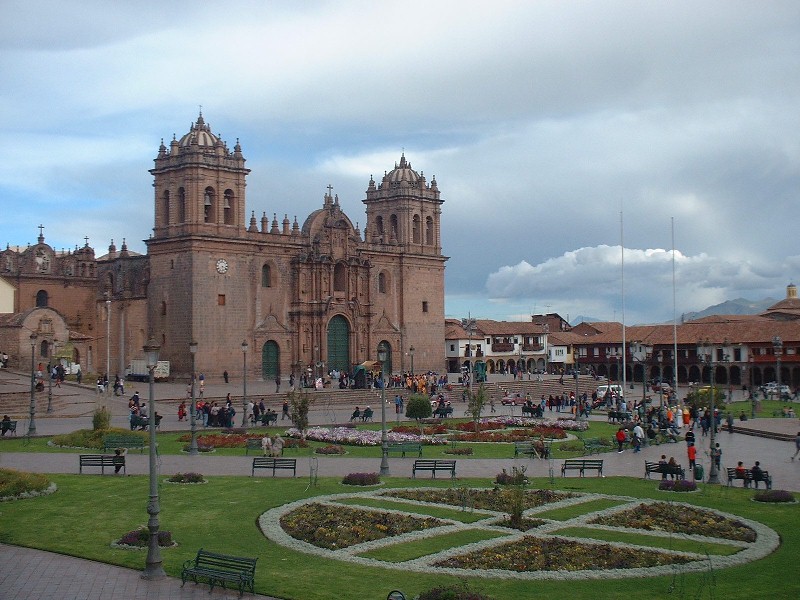
ABOVE: Plaza de las Armas and
the Cathedral in Cusco.
BELOW: Peruvian girl posing with llamas
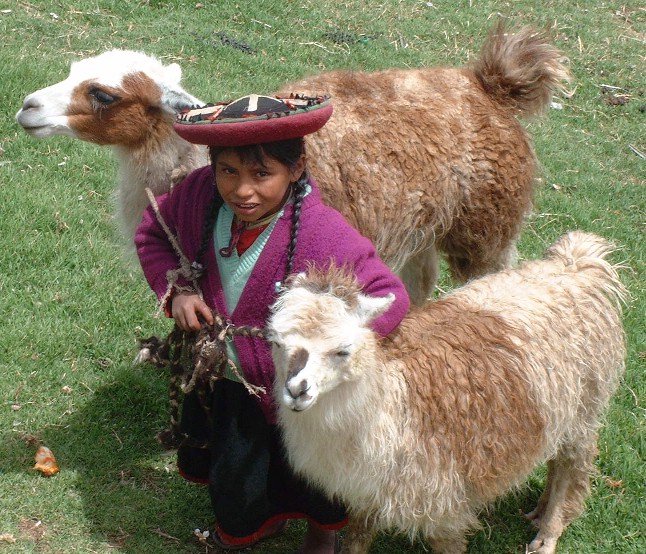

ABOVE: a grotto of skulls and
bones in the catacombs under an old church in Lima.
BELOW: Inca ceremonial bath at Ollantaytambo in the Sacred Valley, with
bus trip guide explaining features.
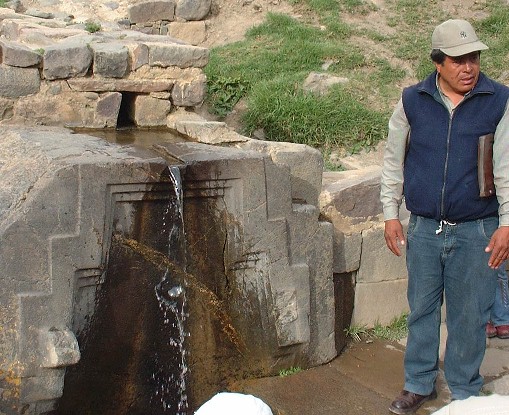
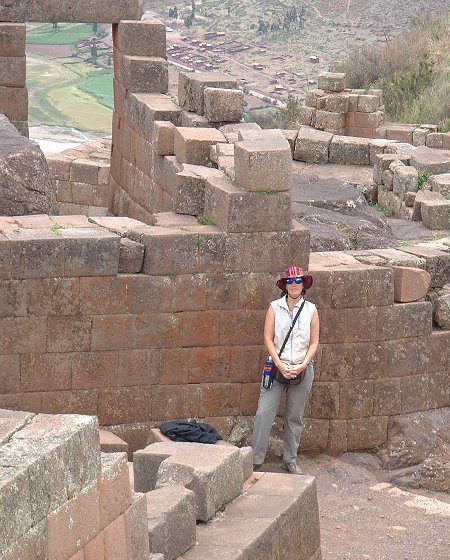
ABOVE: Lisa in the ruins at
Pisaq
BELOW: the southwestern face of Machu Picchu, and the mountain
peak Huana Picchu behind.
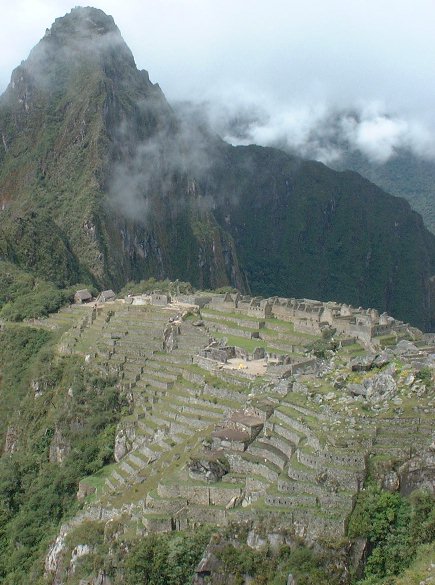 |
|
Lima
- December 2003<
Air travel to Cusco is via Lima ($495
per person round trip
from Caracas to Cusco via Lima – Taca Airlines had a fleet of all new
Airbus
310 jets: nice!). The flight from Lima
to Cusco is a morning flight. The return from Cusco
to Lima
(about US$160 round trip) is scheduled for the morning also, but our
flight was
delayed by fog. In the rainy season, we think this is probably not
uncommon. As
a result of our delayed flight, we had
an unplanned day in Lima and fortunately this led to
our
visiting the Museo de Oro and the Museo Armas del Mundo (combined
ticket price Peruvian
New Sols [s/] 30 or about US$9 per person; open 11:30 AM – 7:00 PM
seven days).
The gold museum is sensational – plan on a minimum of one hour to see
the full
exhibit - and the Museum of Arms
is also probably worth at
least an hour of your time. The gold museum has numerous gold and
silver
ceremonial items, jewelry, and other ornaments. There are many items of
stonework, bronze tools for stonemasonry, feather cloaks from burial
sites of
southern Peru,
many wooden items, and several mummies. In
the museum of arms there is every kind of
weapon from blunderbusses, shogun armor and samurai swords, and
conquistador
equipment, up through the equipment of the first and second World Wars.
There
are hundreds of items. It is
at least
an hour by taxi from the airport.
Both nights in Lima we stayed at La Posada del Parque (monden@terra.com.pe ) – The taxi
from the
airport was US$12, arranged by the Posada each way (if they know your
are
coming, that is . . . ) and charged with the room cost. The room itself
was
US$24. This posada is located in a quiet and attractive neighborhood,
but Lima
in general was about the ugliest city we’ve seen – notwithstanding some
beautiful building facades around the Plaza Mayor. On our unplanned day
when we
made our visit to the gold museum, we hired taxi driver David Barzola
at the
airport (excellent English) to drive us to the posada, and then tour us
around. If you could get him to agree to a rate up front, for his
minor
shortcomings, he might be worth hiring instead of dealing with the mass
of
aggressive taxi and tour sellers waiting at the exit door of the Lima
airport.
Cusco
Various guide sources including
internet pages and Lonely
Planet recommended to avoid packages, but they did not give good
guidance on
what specific tasks would be needed in the absence of guide packages,
so here
are some details:
Cusco is a nice city to explore for a
few days as well as being the base for M.P. visits – it was the capital
of the
Inca empire, after all – there are plenty of hostels and restaurants.
We stayed
at Hostal Amaru www.cusco.net/amaru
and found it an excellent value at US$25/night including breakfast. On
arrival
at Cusco we hired a taxi for our ride to the
hostel (where
we had a reservation). The taxi driver picked up a friend of his to
join us on
the ride. The friend was selling packages and followed us into the
hostel. We
heard him out, promised to call, and he left. Immediately a lady whom
we
thought was an employee of the hostel approached us to apologize for
the
persistence of the salesman and proceeded to begin her own package
spiel. Katherine,
of Marcela’s Travel, was very articulate and professional and we
immediately
fell into the package-buying mode. It was not a big error, but you CAN
do
better.
We wanted to visit M.P. for a couple
of days and get a good
look at Cusco and the surroundings. Our package
included
all the transportation to and from Machu Picchu,
and lodging in Aguas Calientes. We also bought a one-day bus tour of
the Sacred Valley.
To compare: the M.P.
package cost us $250 for two, and got us train tickets on the
backpacker train
($26.78 per person each way – available at the PeruRail station “San
Pedro”), one
round trip bus ticket each ($9 round trip – available at bus-side on a
one-way
basis for $4.50 per person), one admission each to M.P. ($20 per person
per day
– non-negotiable despite insinuations we’d heard otherwise), and a
night’s
lodging with breakfast ($30 at La Cabana; no different than if we’d
chosen this
fine establishment from among the many available in Aguas Calientes) –
total
value $195; plus a large-group guide in M.P. (value unknown, but we
cannot
recommend this – there are plenty of private guides at the entrance if
you have
not researched what you will be seeing) and some taxi transfers (taxis
in Cusco
are 4 sols or about $1 to most locations). Katherine also took us to a
store where
many woolen goods were for sale – but we think the prices were a bit
high. You
could visit there on your own if curious: Perez Factory (phone 232186
in Lima
– their brochure says they will pay for the transportation quite a few
blocks
southeast of the tourist area of Cusco). So,
our package
price included about $35 worth of local knowledge and peace of mind.
We took a bus tour of the Sacred
Valley for $76 for two
people, on
our last day in Cusco. The package included our
Boleto
Turistico ($10 each and this also gained us admission to several Cusco
sites – we would have bought it regardless of whether we took the bus
tour) The
tour visited some local markets and Inca ruins at Pisac, Ollantaytambo,
and
Chinchero. It included a great lunch priced around $3 or 4 per person,
and a
very informative and animated guide. Katherine had offered a private
guide
(taxi) tour of the Sacred Valley for a few dollars more and that might
have
been more enjoyable in some respects (smaller crowds, more time in one
market and
less in another), but it was also enjoyable to talk with some other
tourists as
we traveled – and we had a very enjoyable tour. The Inca ruins in the Sacred
Valley bear many
similarities to
those at M.P, of course. Most of these ruins were right along the route
of the
trainride to M.P.
What we saw and
what we
missed
The cathedral reportedly has a very
important portion of an
Inca temple within, but it was near Christmas and we never were
able to
gain access to the church. When it was open, it was for services only.
We saw
the unavoidable 12-faceted stone and the jaguar image in the wall – do
not accept
any offers to be shown these things. We said no thank you to well over
100
postcard vendors, we visited several museums full of baroque art which
is not
very interesting to us and the Inca Museum on Almirante one block up
hill from
the Cathedral which is not included on the Boleto Turistico but which
is a very
good museum and well worth the small admission fee.
We visited portions of the local
market a few blocks to the
southwest of the Plaza de Armas along Calle Nueve. It is full of
sights, sounds
and smells and seemed safe during the mid-morning hours. Do not be
afraid to
explore it thoroughly. The day we visited the market, we had a great
non-touristy
lunch at Super Pollo on Calle Marquez.
We missed the vast ruin,
Sacsayhuaman, which is located just
NW of Cusco – within 1 km and accessible by walking up hill from the
Plaza de
Armas on Suecia or Procuradores to the road out of town, and then
following it
around the hill to the right past the Church of San Cristobal.
Admission is
with a tourist ticket (boleto turistico) which costs $10. Our bus tour
was to visit this site, but the bus just drove through the area and
our
Boleto Turistico was not stamped for just passing through.
We ate the local corn with gigantic
kernels, we took
pictures of ladies in native costume with llamas, we ate a cuy while in
Aguas
Calientes – pass up your chance at this Inca delicacy! We bought a CD
of flute
music from the young band at the Inca Grill, we bought several “luck
gourds”,
visited the ice-cream shop on calle Ruinas; and admired many alpaca,
baby
alpaca (finer fiber and reportedly not itchy), and plain old wool
sweaters and
hats – good thing we live on a boat in the tropics or the visit to
Cusco could
have been much more expensive!
What We’d Recommend
M.P. is more interesting in the
context of the region, and
we think it would be more interesting to visit after some of the other
sites.
We suggest that a good approach would be to start with a day or two of
acclimatization in Cusco (elevation about
3500m) followed
by a bus or taxi tour of the upper sacred valley. If the tour misses
Sacsayhuaman, then walk there later. Having seen the context, then take
the
backpacker train to M.P. and choose lodgings – don’t rush up the
hill in
the mob. It might be worthwhile to investigate leaving a bus tour late
in the
day and riding the train onward from Ollantaytambo to Aguas Calientes,
even if one spent a night in one of the few posadas at Ollantaytambo.
Take an afternoon to relax in Aguas Caliente and go up the next
morning to
M.P. in the cool of the day. It can easily take two full days to see
the ruins
at M.P. including a hike up to Huayna Picchu, a hike down to Templo de
la Luna,
and a walk over to the Inca Bridge.
If all that walking is not enough, then you can always take the hike
down from
M.P to Aguas Caliente one day.
The M.P. site entrance has a sign
forbidding backpacks and
there is a luggage check before you enter (small fee per bag). However,
most
people entering the park did have on small day-packs and carried water
and
perhaps some snacks. There are no bathroom facilities and no
concessions
inside the
site; so the explorer occasionally finds a remote corner of the ruins
that
unfortunately reeks of urine or encounters a pile of manure not
deposited by a
llama.
M.P is deservedly famous – the vistas
are breathtaking and
the stonework in the temples is amazing – but no better than in some of
the Sacred Valley
sites. We took about 100
digital photos and were fortunately able to get these saved onto a CD
in Cusco
for about US$5 to free up our inadequate camera memory for more
pictures later
in the trip.
Our train to M.P. was fairly empty,
but the return train (leaving
Aguas Caliente at 4:00 PM)
was packed
and there was not much leg room (alternate rows face the opposite
direction, so
every seat is in a group of four passengers face-to-face). Near the end
of the
train ride back, many people chose to switch to a bus which was only $2
per
person and cut out the last 30 minutes of the train ride down the
switch-backs
to town – a close call which option is better. The view of Cusco
at night was pretty and we had fun throwing some candy to kids running
along beside
the train, but after 3+ hours of riding, we were past ready to get off
the
train and find a good restaurant.
In summary –
try to plan days 1 & 2 at Cusco, day
3 touring the Sacred Valley with a transfer to Aguas Calientes late
(maybe this
would be easier if you are on a private tour?); days 3 & 4 at M.P.
with an
evening return to Cusco, and day 5 and maybe 6 back in Cusco catching
missed
sights and possibly hiking up to Sacsayhuaman. Travel well.
|
|
